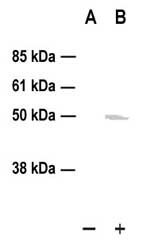PC386
PhosphoDetect Anti-p53 (pSer¹⁵) (Ab-3) Rabbit pAb
liquid, Calbiochem®
About This Item
Biologische Quelle
rabbit
Qualitätsniveau
Antikörperform
affinity isolated antibody
Antikörper-Produkttyp
primary antibodies
Klon
polyclonal
Form
liquid
Enthält nicht
preservative
Speziesreaktivität
rat, mouse, human
Hersteller/Markenname
Calbiochem®
Lagerbedingungen
OK to freeze
Isotyp
IgG
Versandbedingung
wet ice
Lagertemp.
−20°C
Posttranslationale Modifikation Target
phosphorylation (pSer15)
Angaben zum Gen
human ... TP53(7157)
Allgemeine Beschreibung
Immunogen
Anwendung

Immunoblotting (1:1000)
Immunoprecipitation (1:200)
Warnhinweis
Physikalische Form
Rekonstituierung
Hinweis zur Analyse
PC-12, HCT116, or HeLa cells treated with DNA damaging agents
Sonstige Hinweise
Levine, A.J. 1997. Cell88, 323.
Milczarek, G.J., et al. 1997. Life Sci.60, 1.
Shieh, S.Y., et al. 1997. Cell91, 325.
Meek, D.W. 1994. Semin Cancer Biol.5, 203.
Rechtliche Hinweise
Sie haben nicht das passende Produkt gefunden?
Probieren Sie unser Produkt-Auswahlhilfe. aus.
Lagerklassenschlüssel
10 - Combustible liquids
WGK
WGK 2
Analysenzertifikate (COA)
Suchen Sie nach Analysenzertifikate (COA), indem Sie die Lot-/Chargennummer des Produkts eingeben. Lot- und Chargennummern sind auf dem Produktetikett hinter den Wörtern ‘Lot’ oder ‘Batch’ (Lot oder Charge) zu finden.
Besitzen Sie dieses Produkt bereits?
In der Dokumentenbibliothek finden Sie die Dokumentation zu den Produkten, die Sie kürzlich erworben haben.
Unser Team von Wissenschaftlern verfügt über Erfahrung in allen Forschungsbereichen einschließlich Life Science, Materialwissenschaften, chemischer Synthese, Chromatographie, Analytik und vielen mehr..
Setzen Sie sich mit dem technischen Dienst in Verbindung.